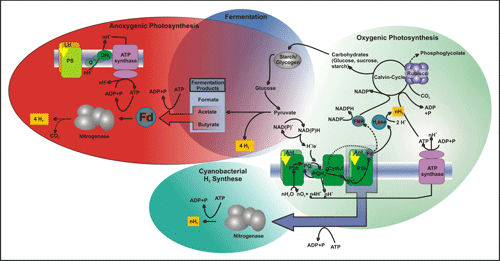BioHydrogen
Overview
Hydrogen is one of the most promising fuels for the future. However, the viability of a future H2 economy depends entirely upon the development of efficient, large-scale and sustainable H2 production systems. Currently, hydrogen is produced using non renewable technologies such as steam reformation of natural gas (~50% of global H2 supply), petroleum refining (~30%) or the gasification of coal (~20%).
A select group of green algae (including Chlamydomonas reinhardtii) and cyanobacteria offer an alternative route to renewable H2 production. These have evolved the ability to use solar energy to produce H2 from water 1, 2. The theoretical conversion efficiency from light to H2 is calculated to be as high (~10%) 3.
Photosystem II (PSII) drives the first stage of the process (Fig.1), by splitting H2O into protons (H2), electrons (e-), and O2. Normally,the photosynthetic light reactions and the Calvin cycle produce carbohydrates that fuel mitochondrial respiration and cell growth. However, under anaerobic conditions, mitochondrial oxidative phosphorylation is largely inhibited. Under these conditions, some organisms (e.g. Chlamydomonas reinhardtii) reroute the energy stored in carbohydrates to a chloroplast hydrogenase (HydA, likely using a NAD(P)H-PQ e- transfer mechanism 4, to facilitate ATP production via photophosphorylation (Fig.1). Thus, H2ase essentially acts as a H+/e- release valve by recombining H+ (from the medium) and e- (from reduced ferredoxin) to produce H2 gas that is excreted from the cell 4. C. reinhardtii therefore provides the basis for solar driven bio-hydrogen production. The combustion of the evolved H2 yields only H2O and thereby completes the clean energy cycle defined by the equations below (see 5-7).
H2 Production
Eq. 1 H2O → 2H+ + 2e- + 1⁄2 O2
Eq. 2 2H+ + 2e → H2
H2 Combustion
Eq. 3 H2 + 1⁄2 O2 → H2O. + 285.8 kJ/mol
Common stream:
The first stage of all biofuel production is the production
of biomass. During the H2 production
phase starch
and other bio-molecules derived from water are converted to
H2.
Specific stream:
The Solar Bio-Fuels Consortium is conducting a wide range of
fundamental systems biology approaches to develop an economically
viable Bio-H2 process. In the first phase of development we patented
the high-H2 producing mutant Stm6 [5]. Hydrogen production capacity was
enhanced by 50% from that of Stm6, through the incorporation of
a sugar transporter to produce Stm6glc4 [5, 8].
Several renewable energy laboratories have concluded that production efficiencies had to be increased from originally 0.2% photon to H2 conversion efficiency at 20W/m2 illumination to ~7-10% at 230W/m2 illumination (day light) to make the process economically viable. As energy prices rise, the required level of efficiency for the process to be economically viable is predicted to fall. Through extensive preliminary work we have already enhanced the efficiency of this process to ~1.0% from light to H2 and 2% to biomass. The H2 gas produced in our mutants has a purity of ~90-95% and typical yields are 500ml H2 for a 1 litre culture (10days; 110W illumination). Without further purification, the H2 gas can used to power a small-scale fuel cell car.

Figure 1: The pathway of bio-hydrogen production in microorganisms [6]
References:
- Melis, A., Zhang, L., Forestier, M., Ghirardi, M. & Seibert, M. Sustained photobiological hydrogen gas production upon reversible inactivation of oxygen evolution in the green alga Chlamydomonas reinhardtii. Plant Physiology 122, 127-135 (2000).
- Ghirardi, M., Zhang, J., Lee, J., Flynn, T., Seibert, M., Greenbaum, E. & Melis, A. Microalgae: a green source of renewable H2. Trends in Biotechnology 18, 506-511 (2000).
- Kruse, O., Rupprecht, J., Mussgnug, J., Dismukes, G. & Hankamer, B. Photosynthesis: A blue print for solar energy capture and biohydrogen production technologies. Photochemical & Photobiological Sciences 4, 957-970 (2005).
- Melis, A. & Happe, T. Hydrogen production. Green algae as a source of energy. Plant Physiology 127, 740-748 (2001).
- Kruse, O., Rupprecht, J., Bader, K., Thomas-Hall, S., Schenk, P., Finazzi, G. & Hankamer, B. Improved photobiological H2 production in engineered green algal cells. J Biol Chem 280, 34170-34177 (2005).
- Rupprecht, J., Hankamer, B., Mussgnug, J., Ananyev, G., Dismukes, C. & Kruse, O. Perspectives and advances of biological H2 production in microorganisms. Applied Microbiology and Biotechnology 72, 442-449 (2006).
- Hankamer, B., Lehr, F., Rupprecht, J., Mussgnug, J. H., Posten, C. & Kruse, O. Photosynthetic biomass and H2 production by green algae: From bioengineering to bioreactor scale up. Physiologia Plantarum 131, 10-21 (2007)

